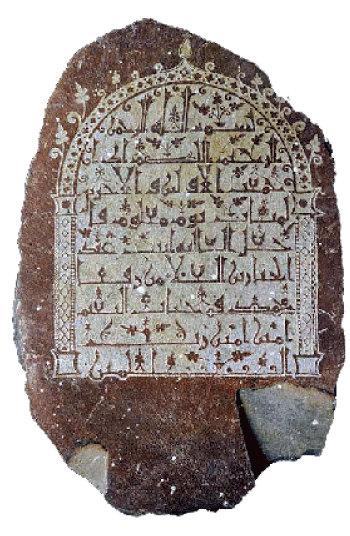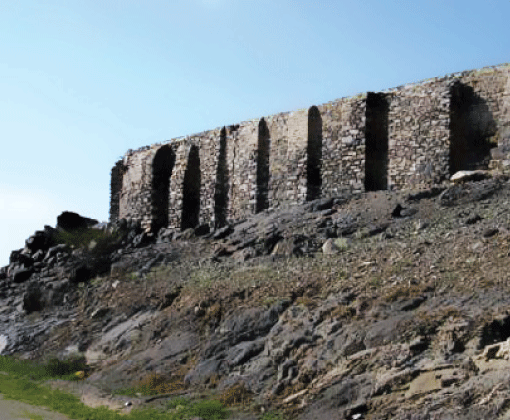
Archaeology of Islamic
Haj routes of Saudi Arabia
 |
Nowhere else in the Islamic world do all of the international pilgrim routes come together within a single country as they do in the Kingdom. Over the past 30 years, the archaeology of the Haj roads of Saudi Arabia has formed an important area of research for the Kingdom's scholars.
By Dr. Geoffrey King
The vast landscape of the long courses of the Saudi Arabian sections of the Haj routes encompasses the diverse countryside of the Kingdom — the desert plains, the coastal strips and the mountains. This is hard to portray in a museum exhibition. By and large, photographs have sufficed in both the Paris and the Barcelona exhibitions and the catalog in order to convey the context and atmosphere of these roads and the harsh beauty of the deserts and mountains that they cross.
Along with the objects excavated, photographs summoned up the physical context of the pious efforts of Muslims over many centuries to strive to reach Holy Makkah to complete their Haj and to stand at the appointed time on the plain of Arafat.
As large Muslim communities developed in countries far beyond Arabia in the early centuries of Islam, the obligation fell upon Muslim rulers to facilitate the journey of the pilgrims from these distant places to complete the Haj and the Umrah at Makkah. Initially, this involved the provision of water tanks and then ever more elaborate facilities to ease the difficult journey across Arabia to Holy Makkah.
Of the network of Arabian Haj routes to the Holy Haramain, that which has been most thoroughly documented is Darb Zubayda, along the course of which Professor Sad Al-Rashid conducted sustained fieldwork over many years. The Darb Zubayda is ancient and was used long before Islam, but it takes its name as a Haj route from the generous sponsorship of Sitt Zubayda, the wife of the Abbasid Khalifa, Harun Al-Rashid, in the late 2nd C. H/8th C.CE.
The archaeological finds from Al-Rabadha, a major town on the Darb Zubayda, were excavated under the auspices of King Saud University, and they form an important part of the exhibition. During the khilafa of Uthman bin Affan, Al-Rabadha became the place of residence of a companion of the Prophet, Abu Dhar Al-Ghifari who died there in 32 H./652-3 CE. In a discussion of the site in the exhibition catalog, Professor Al-Rashid mentions the oldest mosque at Al-Rabadha as being founded by Abu Dhar.
There can be no doubt in the light of the excavations at Al-Rabadha that the foundations of a mosque excavated there belong to one of the older extant mosques of the Islamic world with its foundations and original ground-plan surviving intact.
There are very visible manifestations of the level of Abbasid government investment at Al-Rabadha and elsewhere along the Darb Zubayda under the Khalifa Harun Al-Rashid and his wife, Sitt Zubayda. These include an immensely large water tank and a water cleaning filtration system at Al-Rabadha and of which there are many more at other halts along the Haj route. In such an arid desert a water supply was essential for pilgrims and camels alike, especially in summer.
Other structures at Al-Rabadha included silos for storing grain to provide for the pilgrims on their journey. Organizing food for large numbers of pilgrims crossing the desert was a major logistical task for the Abbasid authorities to which they devoted considerable resources.
The pilgrim traffic through Al-Rabadha would have come from all of the lands of the Islamic East, Al-Mashriq — from the populous Islamic cities of Iraq, from Iran and Central Asia. By the 3rd–4th H./9th C.-10th C. CE thousands annually used the Darb Zubayda to reach Makkah to perform the Haj and this period marks the high-point of Al-Rabadha's development under the Abbasid Caliphate.
The Al-Rabadha finds in the exhibition reflect the level of sophistication of the site in its great days. A formal painted Kufic inscription with the basmala and the shahada of Islam shows the standards of calligraphy at Al-Rabadha and it is evidence of the continuing skill of painting fine writing, khatt, in central Arabia far into the Islamic period.
Glass vessels from Al-Rabadha include some made at the site and other pieces imported from Iraq. At least some of the small glass phials found may have been intended for perfume to be bought at Makkah and for which the holy city was renowned. Ceramics found by the archaeologists at Al-Rabadha encompassed all types of early Abbasid wares, including large blue alkaline glazed jars, gold lusterware plates and other vessels, blue and white wares and splashwares of the finest character, the latter the product of the most advanced kilns of 3rdC. H./9th C. CE Iraq. Such items are prized treasures in museums and private collections today yet this was the pottery for serving the pilgrims in remote Al-Rabadha, far into the central Arabian desert. It is a remarkable reflection of the distribution abilities of the early Abbasid world and the level of comfort provided at Al-Rabadha restaurants.
Steatite or soapstone vessels exhibited at the Louvre and excavated at Al-Rabadha were used for cooking and as oil-lamps. These were found in profusion, made in an Abbasid period factory at the site, the raw material taken from a local steatite mine. Other finds included elegant metalwork and decorated woodwork in typical Abbasid style.
The excavations at Al-Rabadha have been very valuable as the Saudi exhibition showed, but they are only a part of the archaeological picture that will eventually emerge with more research along the Darb Zubayda and its great days under the Abbasid Caliphate. Excavations at Fayd further north on the Darb by the Saudi Commission for Tourism and Antiquities have already revealed its very impressive basalt town walls and a fine water tank. The Basra Haj route is little known but it deserves mention as it provided an alternative to Darb Zubayda.
The potential for future archaeological research on other Haj routes is indicated by essays in the exhibition catalog. An overview of the Syrian Haj route is given by Hayat Al-Kilabi, and excavations at Qurh or Al-Mabiyat, a Syrian Haj route site, recorded by Abdallah Al-Umayr, confirm the importance of this early Islamic Haj stop near ancient Lihyanite Dedan. Ali Ghabban has summarized the impressive sequence of archaeological sites and massive fortresses that served the Egyptian Haj route down to Ottoman times while Muhammad Al-Thunayan records the virtually unknown wealth of Islamic archaeological sites in the southern mountains of Saudi Arabia through which the Yemeni Haj caravan would pass. Research on the major pilgrim routes crossing Saudi Arabia in coming years has the potential for transforming our view of the Kingdom's archaeology.